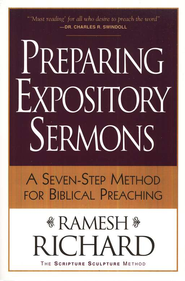
This book review of Ramesh Richard‘s Preparing Expository Sermons was written as part of Pastor Lane’s doctoral course work, and as such, it is written in a more formal, academic tone than the rest of this blog’s posts. Still, we hope the audience will find these academic book reviews useful, which is why we have published them for your reference.
Preparing Expository Sermons focuses its principle content on the pathway for building the sermon, “the art and science of sculpting a sermon from Scripture,” with its final chapter addressing the preaching of the sermon. Summarizing the advantages of expository preaching for the congregation and the preacher, the author states “expository preaching helps the preacher promote God’s agenda for his people.” This articulates a strong and excellent challenge for expositional preaching. The introduction covers three essentials in message preparation, the “what,” “how,” and “why” of expository preaching. A final helpful element of the introduction that the author gives is to cover the entire book outline to give a picture for where he will lead the reader.
 The first chapter offers a number of relationships to recognize in study. The “psychological relationships,” in particular, I find more confusing than helpful. The strength of this chapter resides in the “tests” for the student to utilize in study, including authenticity, unity, consistency, simplicity, and honesty. The second chapter deals with grammatical issues and helping the student to get a handle on the text flow. The simplicity of this chapter helps make the process easier and more manageable.
The first chapter offers a number of relationships to recognize in study. The “psychological relationships,” in particular, I find more confusing than helpful. The strength of this chapter resides in the “tests” for the student to utilize in study, including authenticity, unity, consistency, simplicity, and honesty. The second chapter deals with grammatical issues and helping the student to get a handle on the text flow. The simplicity of this chapter helps make the process easier and more manageable.
The next three chapters cover the core of sermon development, from the central proposition of the passage to the purpose to the central proposition of the message. The first seeks to find the heart, or main meaning, of the text. The second becomes what the author calls the “brains” of the sermon, or “the most critical part of the entire sermon-preparation process.” The third is the heart of the sermon. The author provides a helpful connection in the way he structures his material, and through content, of helping the student to connect these three steps in the process. Understanding the relationship here establishes the vital link of expository preaching as the author notes, “It is often possible to turn the purpose of the sermon into the theme of the sermon.”
The author uses chapters six and seven to explain sermon structure and delivery. He helps the reader think through how he wants to structure the message according to the passage itself. A number of excellent issues are addressed in delivery consideration as well.
Three unique qualities of this book distinguish it. First, the use of “Action Steps,” an exercise in each chapter for the reader to practice what he was reading connects practice to learning while reading for the student. Second, the path the author creates helps the student to see the parallels of preparing the sermon with preaching the sermon. This parallel gives the benefit of connecting the preaching event to the study practice and shapes the student’s thinking throughout the preparation. It creates a stronger tie to study in delivery as well. Third, the appendices are extensive and used by the author to address important issues topically without expanding on them within each chapter. This provides a great resource for future reference, without having to re-read or peruse the entire book. This appears to me the most overall helpful aspect of the whole book.
More book reviews by Pastor Lane:
February 7, 2013
Love your book reviews. Enjoy reading them so much!! So proud of you!! Much love